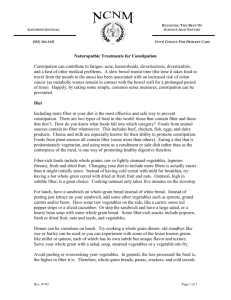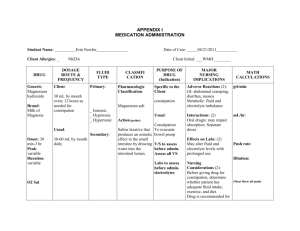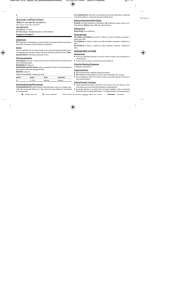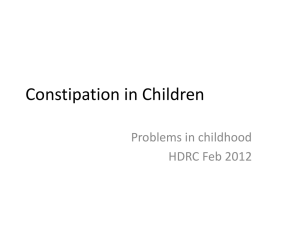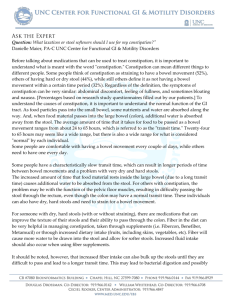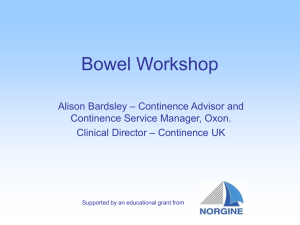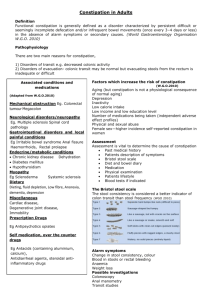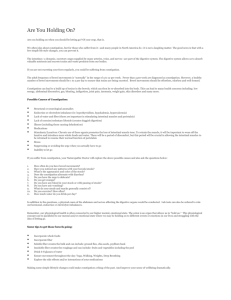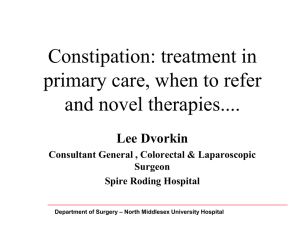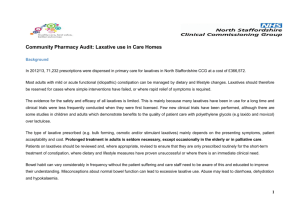Constipation CPG - Acute Care Geriatric Nurse Network
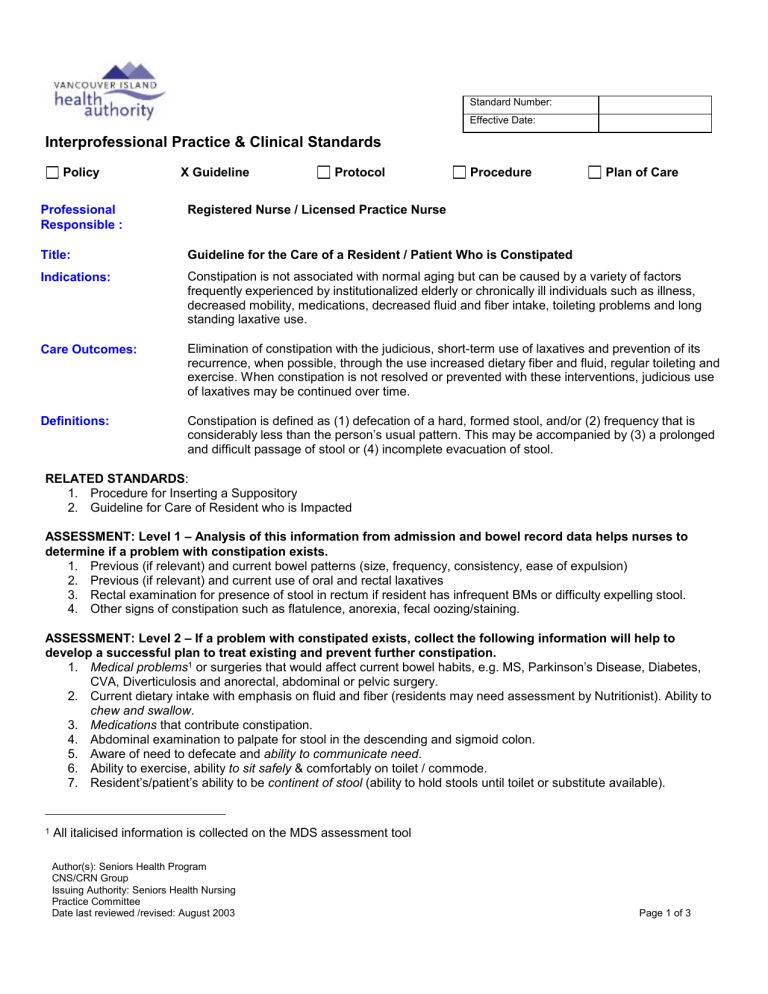
Interprofessional Practice & Clinical Standards
Policy X Guideline Protocol
Standard Number:
Effective Date:
Procedure Plan of Care
Professional
Responsible :
Title:
Registered Nurse / Licensed Practice Nurse
Guideline for the Care of a Resident / Patient Who is Constipated
Indications: Constipation is not associated with normal aging but can be caused by a variety of factors frequently experienced by institutionalized elderly or chronically ill individuals such as illness, decreased mobility, medications, decreased fluid and fiber intake, toileting problems and long standing laxative use.
Elimination of constipation with the judicious, short-term use of laxatives and prevention of its Care Outcomes: recurrence, when possible, through the use increased dietary fiber and fluid, regular toileting and exercise. When constipation is not resolved or prevented with these interventions, judicious use of laxatives may be continued over time.
Definitions:
RELATED STANDARDS :
Constipation is defined as (1) defecation of a hard, formed stool, and/or (2) frequency that is considerably less than the person’s usual pattern. This may be accompanied by (3) a prolonged and difficult passage of stool or (4) incomplete evacuation of stool.
1. Procedure for Inserting a Suppository
2. Guideline for Care of Resident who is Impacted
ASSESSMENT: Level 1 – Analysis of this information from admission and bowel record data helps nurses to determine if a problem with constipation exists.
1. Previous (if relevant) and current bowel patterns (size, frequency, consistency, ease of expulsion)
2. Previous (if relevant) and current use of oral and rectal laxatives
3. Rectal examination for presence of stool in rectum if resident has infrequent BMs or difficulty expelling stool.
4. Other signs of constipation such as flatulence, anorexia, fecal oozing/staining.
ASSESSMENT: Level 2 – If a problem with constipated exists, collect the following information will help to develop a successful plan to treat existing and prevent further constipation.
1. Medical problems 1 or surgeries that would affect current bowel habits, e.g. MS, Parkinson’s Disease, Diabetes,
CVA, Diverticulosis and anorectal, abdominal or pelvic surgery.
2. Current dietary intake with emphasis on fluid and fiber (residents may need assessment by Nutritionist). Ability to chew and swallow .
3. Medications that contribute constipation.
4. Abdominal examination to palpate for stool in the descending and sigmoid colon.
5. Aware of need to defecate and ability to communicate need .
6. Ability to exercise, ability to sit safely & comfortably on toilet / commode.
7. Resident’s/patient’s ability to be continent of stool (ability to hold stools until toilet or substitute available).
1 All italicised information is collected on the MDS assessment tool
Author(s): Seniors Health Program
CNS/CRN Group
Issuing Authority: Seniors Health Nursing
Practice Committee
Date last reviewed /revised: August 2003 Page 1 of 3
Title: 726866306
INTERVENTIONS to manage constipation include:
1. Dietary Interventions
Page 2 of 3
At the same time that constipated stool is being cleared, implement measures to soften and bulk the stools. a. Minimum fluid intake should be 1200 mls daily unless contraindicated for medical reasons; 1500 – 1600 ml is preferable. Ideally, if residents/patients are able, they should drink 30 mls / kg body weight daily. Once a current fluid intake has been assessed, consult with the Nutritionist, to assist setting up amounts and type of fluid intake. Refer to the Nutritionist / SLP if the resident/patient has swallowing difficulties. Decaffeinated beverages are preferred. b. If stools are hard formed or putty-like with little bulk and are difficult to expel and the resident/patient is taking at least 1000 ml fluid, add fiber to the diet with added prunes, high fiber cereal or fruit laxative (ground prunes and wheat bran). Fiber should be increased by no more than 2.5 – 5 gm daily and there should be 1 week between increases to allow the gut to adapt to the additional fiber. Can increase to 30 gm daily if needed.
Decrease amount of resident has cramping or loose stools.
2. Other Preventive Interventions a. Toileting – the resident should be placed on a toilet or commode after meals, as this is when the gastrocolic reflex is most active. Support the feet as necessary to promote appropriate hip flexion to promote defecation.
Hip flexion and a forward thrust of the body increase intra abdominal pressure, which supports defecation with less straining. Residents/patients should be comfortable and have sufficient privacy when having a BM. b. Constipating Medications – Review the medications and collaborate with the Pharmacist to determine if there are alternate, less constipating medications that are appropriate for the resident/patient and could be discussed with the GP. c. Exercise – Consult with the OT/PT to explore exercise options for the resident/patient.
3. Laxative Use a. Treat constipation with laxatives to ensure that the resident/patient has a regular BM – See Guidelines for
Laxative Therapy 2 (attached). Laxatives work to move stool through the bowel into the rectum by bulking stool and promoting peristalsis. Oral laxatives may or may not promote expulsion. If the resident/patient is unable to effectively clear their rectum, use rectal laxatives. Consult the physician if the resident’s/patient’s response to the Laxatives Guidelines is not satisfactory. b. If the constipation is not resolved with dietary and toileting measures, it may be necessary to continue laxative use.
EVALUATION
1. Review the bowel record to determine if the resident/patient is passing between 2 and 7 soft formed BMs weekly with each stool being no less that 1 cup. If this is not occurring, increase preventive intervention and consult with the physician.
2. The intervals between stools will be as close to past habits as possible with the use of least invasive measures to support defecation.
DOCUMENTATION
1. Any change in bowel habits or treatment plans is documented on the progress notes and appropriate assessment
& intervention occurs and is documented on the chart as necessary. The physician is notified of any changes as necessary
2. The Bowel Record is completed each day for each resident.
2 Requires physician order
Standard Number:
Effective Date:
Interprofessional Practice & Clinical Standards
Treatment Guideline Oral & Rectal Medication Options
Prevention
Treatment – Constipation
Day 1-2
(after normally expected stool)
Day 2-3 (if no BM Day 1-2)
Day 3-4 (if no BM Day 2-3)
Day 4-5 (if no BM Day 3-4)
Bulk Producing Laxatives
1. High Fiber diet / Fruit Laxative
2. Psyllium 5mL (7g) up to TID, Mix and administer each dose with
250mL cool liquid
No laxative – toilet as required
Osmotic Laxative: Lactulose 15
– 30 ml daily.
Mix with fruit juice. Morning preferred dosing time.
OR
Stimulant Laxatives: Sennosides 12-24 mg HS
Hyperosmotic Laxative: Glycerin 2.65g suppository in am
OR
Stimulant Laxative: Bisacodyl 10mg suppository in am
Osmotic Laxative: Lactulose 15 – 30 ml daily if suppository not effective.
*Morning preferred dosing time.
OR
Stimulant Laxatives: Sennosides 12-24 mg HS if suppository not effective.
Saline Laxatives:
Sodium Phosphates (Fleet) 100mL in a.m.
OR
Sodium Citrate and Sodium Lauryl Sulfoacetate
(Microlax) 5mL rectally in am.
Onset of Effect
Onset 12-24 hours, full effect 2-3 days
24-48 hours
6-12 hours, full effect 24 hours
15-30 minutes
15-60 minutes
24-48 hours
6-12 hours
2-5 minutes
5-20 minutes
Treatment
– Impaction
Day 5-6 (If no BM Day 4-5) Saline Laxatives:
Magnesium Hydroxide and Mineral Oil Emulsion
(Fleet Mineral Oil Enema)
Give 100mL rectally prior to digital disimpaction.
2-5 minutes
References:
1. Doughty, D. (2000) Urinary and Fecal Incontinence: Nursing Management. Mosby: St. Louis
2. Hert M, Huseboe J. (1998) Management of constipation: Research-based protocol. University of Iowa Gerontological Nursing Intervention
Research Center, Research Dissemination Core.
3. Wilson, J. (1999) Constipation in the elderly. Clinics in Geriatric Medicine; 15(3). 499 – 510
4. Stone, J et al (1999) Clinical Gerontological Nursing – A Guide to Advanced Practice (2 nd ed). WB Saunders
5. Wald, A. (2000). Constipation. Medical Clinics of North America; 84(5); 1231 – 1246.
6. Benton, J. et al (1997). Changing bowel hygiene practice successfully: A program to reduce laxative use in a chronic care hospital. Geriatric
Nursing; 18(1).
7. Voderholzer, W. et al (1997) Clinical response to dietary fiber treatment of chronic constipation. American Journal of Gastroenterology. 92(1);
95-98.
8. Gibson, C. et al (1995). Effect of bran supplementation on the bowel management of elderly rehabilitation patients. Journal of Gerontological
Nursing. 21(10). 21-30.
9. Cheskin, L. (1995). Constipation in older persons and effects of fiber compared with placebo. JAGS. 43(6). 666-669.
10. Harari, D et al (1994). Constipation: assessment & management in the institutionalized elderly population. JAGS. 42(9). 947-952.
11. Hull, C. (1980) Alleviation of constipation in the elderly by dietary fiber supplementation. JAGS. 28(9). 410
– 414.
Author(s): Seniors Health Program
CNS/CRN Group
Issuing Authority: Seniors Health Nursing
Practice Committee
Date last reviewed /revised: August 2003 Page 3 of 3
